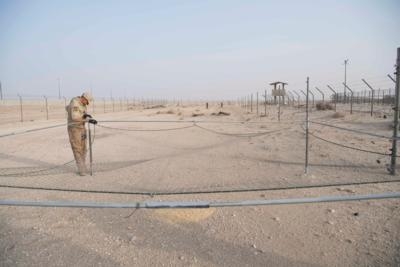Being Deployed In The U.S. Air Forces Central Command In Southwest Asia's Area Of Responsibility
The U.S. Department of Agriculture works with safety teams around the Air Force to limit the presence of birds on and around airfields to protect aircraft from bird strikes, an issue that costs the Air Force millions of dollars every year in damages.

At the busiest airfield in the U.S. Air Forces Central Command in Southwest Asia, the USDA team has taken a system for catching birds used at a few stateside installations in the Air Force and created one fitted for use in the desert.
Ted Pepps, USDA wildlife biologist, designed a drop net system for the area of responsibility and worked with the base’s Combat Metals shop to build it in-house. “The drop net is a mass capture device,” said Pepps. “It allows us to catch more birds in a shorter amount of time. It is more efficient and effective. Back home we use it for bird control and wildlife research, and we hope to do the same here.”
The simple design horizontally suspends a 15 foot by 15 foot net between electromagnets powered by a car battery. The operator drops the net flat to the ground on unsuspecting birds using a remote similar to a garage door opener with a range up to about a football field. Most birds are skeptical of changes in their environments, so, the USDA members here do not drop the net daily. Once the birds have acclimated to the device, which normally takes a few days, they go out and drop it early in the morning while the birds are eating seed placed under the net.
Once captured, the birds are humanely removed from the area. “This is a big deal in the AOR because there are a lot of sensitive areas,” said Pepps. “Areas that we can’t shoot guns or pyrotechnics, so this [system] will fill that void.”
“A system like this demonstrates the potential that our Airmen from all components of the Total Force—civilian, Guard or Reserve, or active duty—have to make a difference through their ingenuity and creativity,” said Lt. Col. Edmund Harrington, U.S. Air Forces Central Command Deputy Director of Safety. “Mr. Pepps’ drop net presents a simple solution to a variety of challenges with mitigating the wildlife strike risk in the AOR.”
This solution will not completely phase out other cages and traps that require the constant attention of USDA personnel. Those methods still require the team to replenish the food and water, and they can’t leave the birds exposed to the elements. The traps must be checked often to ensure that when a bird is captured, it remains alive. “With most traps, you use a lot of man-hours for a minimal result,” added Pepps. “With the drop net, where you pull the birds out immediately, there is not a huge time commitment with catching 50 to 100 birds.”
The entire system is mobile and can be easily placed in a variety of locations, ensuring that it can be used wherever the birds relocate, said Pepps. The drop net system is placed away from the airfield and attracts the birds that would normally fly in the vicinity of the flightline as well as other important areas around base. “We hope to see devices like this one in broader use throughout the AOR, and I encourage our safety teams to look for other innovative ways to reduce mishap risks for our Airmen and Joint and Coalition partners,” said Harrington.
(Image provided with USAF news release)
 ANN's Daily Aero-Term (05.01.24): Say Altitude
ANN's Daily Aero-Term (05.01.24): Say Altitude ANN's Daily Aero-Linx (05.01.24)
ANN's Daily Aero-Linx (05.01.24) Classic Aero-TV: Korean War Hero Twice Reborn
Classic Aero-TV: Korean War Hero Twice Reborn Airborne 04.29.24: EAA B-25 Rides, Textron 2024, G700 Deliveries
Airborne 04.29.24: EAA B-25 Rides, Textron 2024, G700 Deliveries Airborne Affordable Flyers 05.02.24: Bobby Bailey, SPRG Report Cards, Skydive!
Airborne Affordable Flyers 05.02.24: Bobby Bailey, SPRG Report Cards, Skydive!



